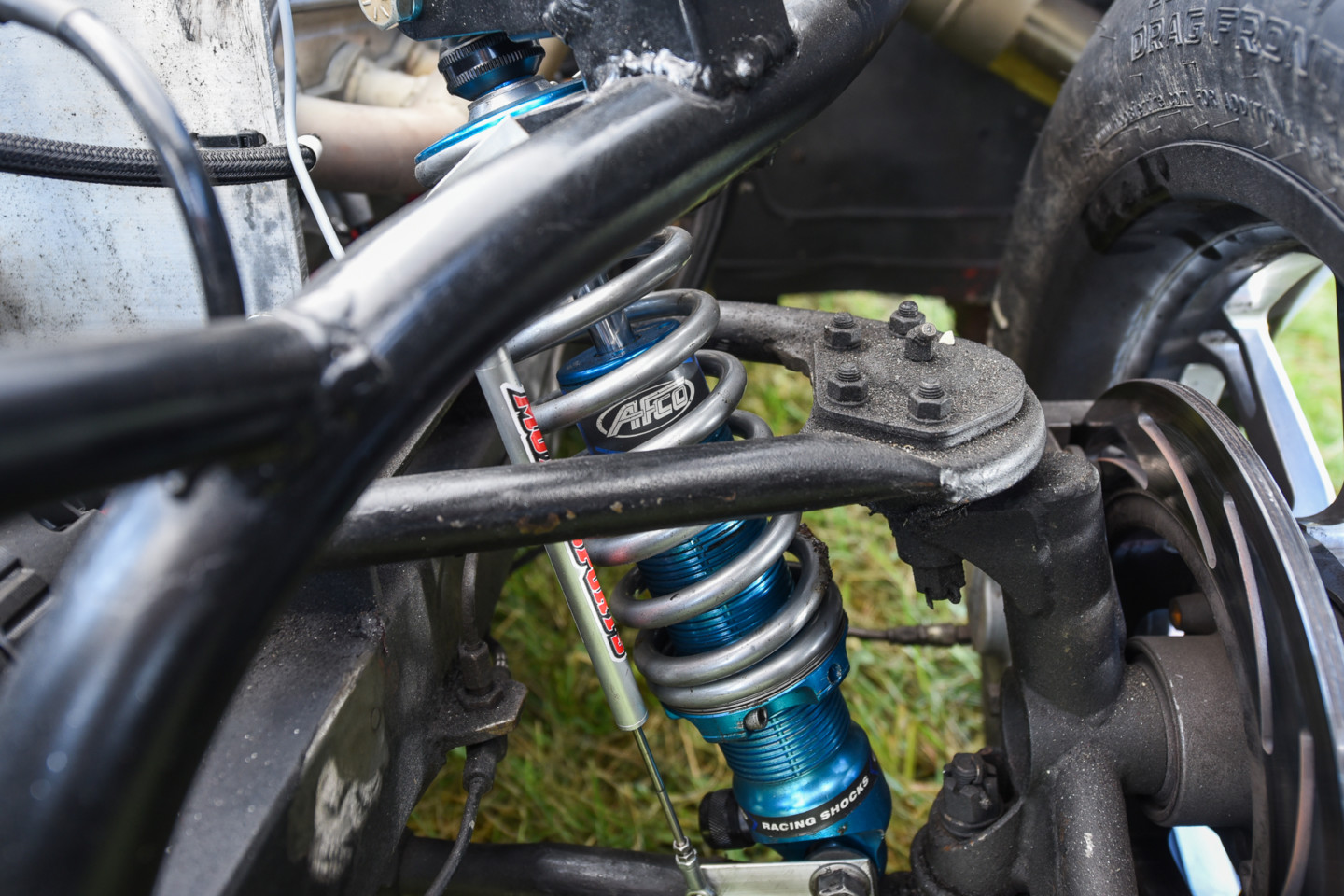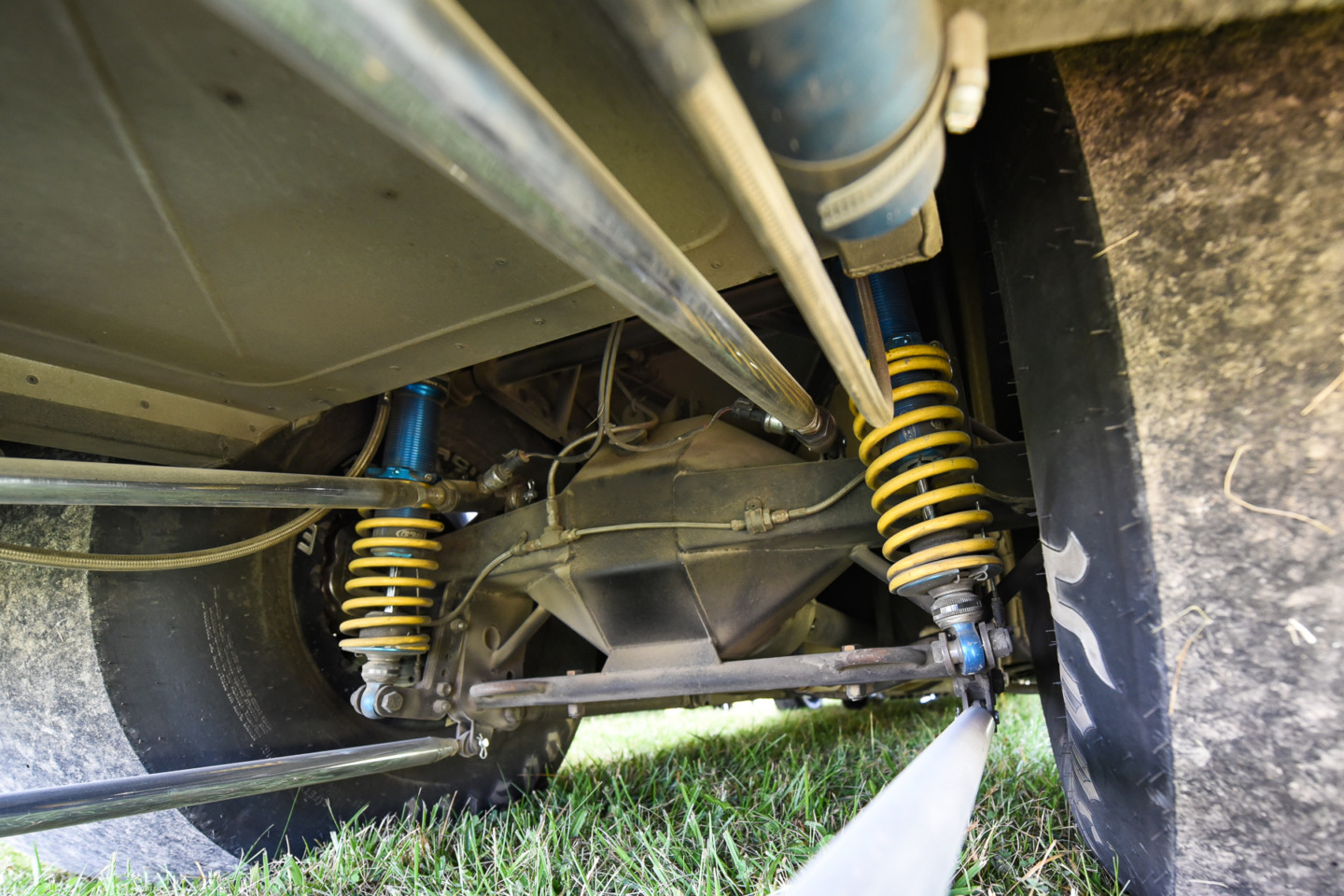This article was originally posted on Dragzine here: https://www.dragzine.com/tech-stories/planted-power-drag-racing-shock-buying-tips-with-afco/
Selecting the right set of shocks for your drag racing application is an incredibly important task. Different forms of racing require a certain type of shock, and there are numerous factors that determine the shock that will work best for a specific vehicle. We spoke with Eric Saffell, National Account Manager at AFCO to learn more about shock selection, what shocks work for certain applications, and how to get the most out of your shocks.
Just because a shock will fit on your vehicle doesn’t mean it’s going to be the right shock for your racing program. The type of racing you’re going to do, the engine you use, the type of transmission, and other factors all play into selecting the right product for your application. You also need to think about any future changes you may make to the vehicle before you purchase a set of shocks.
The type of racing you do will dictate the shocks you need to use. Horsepower, type of tire, and condition of the surface are just a few factors to consider, as well.
“It’s important to first evaluate the target for the build in terms of performance. It’s also helpful to look at the vehicle’s current setup and think about what you want to do in the future to ensure you make the correct purchase the first time. This can save you some money and will help improve the vehicle at the track,” Saffell says.
This type of information will help you decide if a single- or double-adjustable shock is right for your vehicle.
So, what’s the difference between a single- and double-adjustable shock? It comes down to how the shock functions and how it can be adjusted. Some single-adjustable shocks tune only compression, and some change both compression and rebound in a fixed ratio with a single adjustment. We should specify that specifically AFCO’s shocks adjust only extension, called rebound. A double-adjustable shock allows you to make adjustments to how the shock’s extension and rebound behave independently of one another.
Single- and double-adjustable shocks come in many different forms. The amount of horsepower you’re trying to put down will play a role in what type of shock you need.
To finish this quick crash course in drag racing shock basics, Saffell provides a short summary of how the right shocks will help a vehicle perform better at the track.
“Since shocks control when the weight gets transferred like timing devices, the correct shock for the application provides proper force values to manipulate the suspension as desired. A shock valved for a Pro Modified car doesn’t need to be on a 10-second car. Also, a car that does big wheelies needs a shock specifically valved for landing all that weight each pass. Each vehicle has different needs so it’s important to keep that in mind when shopping for shocks.”
Bracket And Index Racing Shocks
Bracket and index racers make up the largest portion of drag racing participants. Everything from 20-second street cars, to 6-second Top Dragsters live in the bracket and index racing world.
Consistency is key for bracket and index racers, so they need to know what their vehicle is capable of running if they’re going to select the right set of shocks. Saffell explains what these racers need to look at when it’s time to purchase a set of shocks.
Bracket racers will reap big benefits from a set of shocks that can be tuned for their application.
“First, you need an honest assessment of the goals for the vehicle. Are you looking for a maximum-effort shock, or are you just starting out and on a budget? If the goal is to build a combination that can compete with the best, make sure the investment matches that goal. A shock that’s ‘good enough’ isn’t going to be in the equation and won’t give you the results you’re looking for in a high-end build,” Saffell says.
At AFCO, we have many variations of valve codes to fit the various types of rear suspensions, tire sizes, and e.t. ranges. – Eric Saffell, AFCO
For a vehicle that still has shocks that mount in an OEM-type of position and is making a reasonable amount of horsepower, a standard configuration single- or double-adjustable shock will work. If you’re making big horsepower, a double-adjustable that uses a remote canister, or a four-way adjustable that provides maximum control might be the right choice. AFCO offers all of these types of shocks for different applications.
The more horsepower a bracket racer is working with, the more important the right set of shocks becomes to their program.
To get the most out of your bracket racing shock package you need to be prepared to do a lot of testing, and document everything about each run.
“Testing done right is tough work. You must establish the baseline, make an adjustment, and record the data. Next, you have to evaluate the change in performance, and either accept the results or decide to make another change followed by another pass. You need to repeat the assessment process against the baseline. Sometimes, we need to make a suspension change and adjust the ladder bars, pinion angle, or four-link, and then go back to the shocks through the assessment process,” Saffell explains.
Shock adjustments need to be viewed and approached from a fine-tuning point of view. To get the best results you should only make one change at a time — this will help determine what the effect was and make it easier to track. Remember, the goal of bracket racing is to be consistent as possible, so knowing what each change does is critical.
Heads Up Racing Shocks
The shocks you select for a heads-up racing application are going to be much different from a bracket racing application. Your typical heads-up race car is going to be a max-effort build that’s running on the ragged edge most of the time, and needs to put as much horsepower down as possible. That means you need a shock package that’s highly adjustable and geared to your combination.
Heads-up racers need a set of shocks that can be fine-tuned to the track conditions.
“When a racer comes to us looking for shocks that will be used on a vehicle that’s going heads-up racing there are certain things we need to know. To select the right shocks, we’ll need to know what tires the vehicle is going to be racing on, anticipated e.t., estimated horsepower, the power-adder being used, the type of rear suspension, and how it will be tuned. As power and torque go up and as projected e.t.’s come down, we might need a shock built specifically for the application,” Saffell says.
Heads-up racing is very demanding on shocks and each vehicle has different shock requirements. AFCO has worked hand-in-hand with teams at all levels of heads-up racing to develop three different shock packages that are designed for this type of racing.
“The Eliminator non-canister shock series offers racers plenty of features and a very wide range of adjustments for a great value. We recommend this style shock for vehicles that make up to 1,500 horsepower. The remote canister shock series offers superior suspension control, based on its design, and gives the tuner the necessary damping parameters to control high-horsepower applications. The nitrogen charge prevents fluid cavitation inside the shock that can exist with big power and aggressive suspension setups. The third option is the AFCO Dominator four-way shock. This shock offers independent low- and high-speed adjustments, both on the rebound and compression side. The valving design is unique yet user-friendly, and provides the turner the ability to shape the curve of the shock graph. You can also tune for ultimate separation or squat while defending against tire shake,” Saffell explains.
Testing done right is tough work. You must establish the baseline, make an adjustment, and record the data. – Eric Saffell, AFCO
Heads-up race cars require a lot of testing to get dialed in, but it has to be quality testing to get the best results. When testing is done right, it will allow the racer to gather good data about what the shocks are doing each pass. So, to get the most out of your heads-up racing shock program you need to be ready to burn a lot of fuel while recording data and getting a baseline.

Data collection is critical to get the most out of a set of shocks on a heads-up race car.
“The more data that can be recorded from each pass the better. The team can watch video from the run, look at onboard data, and talk with the driver to assess the situation and make the proper tuning decisions. Compromise is a word we all use at times, however when it comes to shock tuning and adjustments, the more passes you make, the more you’ll learn, and the quality of your adjustments will go up,” Saffell states.
No Prep Racing Shocks
Bracket racers, index racers, and heads-up racers are used to dealing with a surface that’s pretty consistent. No-prep racers are on the opposite end of the spectrum. No-prep racers could face a track surface that changes multiple times in just one round of racing, so their shock needs are going to be vastly different from other forms of racing.
“No-prep racing is another form of drag racing that can require a specific valve package, depending on how the car is set up. Due to the nature of this style of racing, it’s most important to select a shock that has a wide range of adjustments, can be easily rebuilt, and have valving changed, plus can be tuned to control the chassis. Horsepower, size of tire, and the surface all factor into the proper shock choice,” Saffell says.
No-prep racers are going to use every adjustment a shock has to gain maximum traction.
AFCO has developed several shock options for no-prep racers to help them get the most traction possible on a marginal surface.
“The non-canister shock is a good choice and offers a very wide range of adjustment. The canister shock is the next step up and, due to its design can handle elevated levels of horsepower. The key is to understand how the car will be tuned and then choose the correct shock. If the car is going to be set up to squat, our Big Gun valving is preferred. If we are set up to separate, then the Big Gun X (BGX) radial shock valving is the way to go. This valving is available in all the popular shock lengths offered by AFCO,” Saffell explains.

A no prep racer will do a lot of testing to help get the most out of their shocks.
No-prep racers reap huge benefits from testing when they’re trying to learn how to set up their shock package. Your data log needs to be extensive as a no prep racer since you’ll face so many different surfaces under a wide range of conditions each season.
“Collecting data will shorten the learning curve for no-prep racers, and with that, I would encourage racers to make adjustments along the way to see cause and effect. Log the changes, note the performance change, and make notes to yourself so that when these conditions arise again, you can refer back and make the proper changes. Shocks that have a wide range of adjustment, can repeat from adjustment to adjustment, and are engineered for the type of racing you’re doing is critical to ensure you get the most out of your shock program,” Saffell says.
Selecting the right shocks for your racing program is one of the most important decisions you’ll make. If you take the time to speak to the experts like those at AFCO and review your options it will make the process much easier.